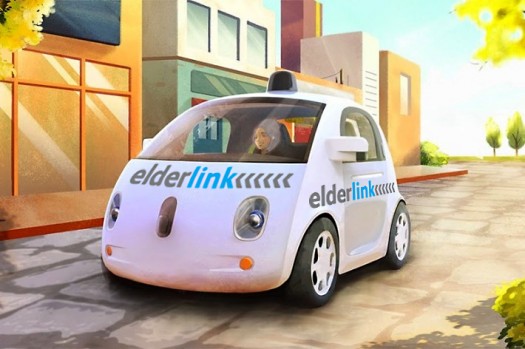A Placemaking Journal
Aging, Self-Driving Cars, and How We Suck at Predicting Doom
As a species, we like to keep on keepin’ on. We’re predisposed to favor continuity and resist change. Which includes not wanting to be held accountable for any less-than-stellar choices we might make along the way.
For years we’ve had various prophets of doom telling us that dispersed suburban living is one of those less-than-stellar choices and that reality — in various forms — is poised to soon intervene, forcing exactly the types of change we’re so prone to denying.
One of these realities has been the prospect of Peak Oil. We may have different ideas about exactly what that represents but, almost universally, we all agree that oil is a limited resource and that it will inevitably deplete.
Easily extractable reserves dwindle and prices go up, comprising the reality many suggested would drive the widespread emergence of less energy-consumptive lifestyles. But, as it turns out, it was instead the reality that drove innovation in oil extraction. Suddenly, we’re getting a lot more energy from tar sands or shale or whatever, and supplies are seemingly no longer limited. Prices drop.
To the everyman, this delivers the gift of inertia. What’s easier: changing where and how you live or simply doing nothing and being cool with however it is that your affordable energy gets delivered?
Exactly.
Our senior moment
Presently affordable gas has, at least for the time being, taken the urgency out of energy as an agent of lifestyle change. People may, in significant numbers, be migrating closer into cities or otherwise changing their habits but, for those who are, the cost of energy is no longer the typical driving factor.
But fear not, ye disciples of doom! There’s no shortage of boogeymen on the suburban horizon. And for the past several years, we’ve been reading a lot about one in particular: aging Baby Boomers.
In short, the auto-dependent physical patterns of the suburbs are not particularly conducive to the challenges of aging. Once you can no longer drive (or drive safely), you’re increasingly stuck and reliant on others for your basic needs. Walking is often difficult and, even when it isn’t, amenities and transit are too far away to access easily.
The idea is that, increasingly, the nation’s 76 million Baby Boomers will experience their great reckoning and begin coming to terms with the fact that their aging-in-place plans simply aren’t tenable. In response, there’ll be an enormous senior sell-off of real estate that may present its own sub-crisis, as Boomers meet a marketplace dominated by Millennials who simply don’t want to buy their homes.
Doom delivered. Happy now?
You never know what reality will inspire
But here’s the thing: Just like innovation in oil production reduced or eliminated (albeit temporarily, as measured by the Long Now) our need to change anything about how we consume energy, there’s always the possibility that similar efforts will emerge to address our present challenges with aging.
I’m talking about autonomous cars.
That’s not to say I’m advocating for autonomous cars. In fact, I’m not altogether keen on them at the moment because their rise, in many ways, seems likely to perpetuate patterns of development that, in my opinion, are contrary to the our best interests overall.
But we can’t just say “autonomous cars will disincentivize the adoption of walkable, urban living, so we must immediately stop working on them.”
The technology will continue to be developed and the products, whatever they prove to be, will ultimately be implemented in various ways. Exactly what ways, as of now, is speculation. But we can’t deny it’s happening. And will continue to happen.

Thus, who’s to say it won’t rise to offer on-demand transportation for huge populations of housebound seniors — eliminating not just the hurdle of mobility but, equally of note, the anxiety associated with being dependent on others?
Given our (long view) energy reality, such an approach may not come to be a sustainable solution overall but perhaps it could be one capable of getting us through the next half century or so. Long enough to cope with our bulges in population.
The point
I’m not here to advocate for particular solutions or responses, nor is my intention to chide our many prophets for seemingly not being accurate.
Instead, I’m here to make a plea for humility.
When we’re too sure of what lies ahead and we try to use such daunting scenarios as supporting points in advocating for the things we believe in (in this case, compact, walkable urban places), we invariably find our efforts called into question as reality fails to play out quite as simply and cleanly as we’d like.
Telling people to change their ways because we’re headed to hell in a hand basket invites questions as to how comfortable the basket may be and whether we’ll arrive at our destination before or after we’ve personally shuffled off to another plane.
Instead, our advocacy should be rooted in incentives. That is, we can and should inspire changes in lifestyle, but do it by continuing to build better places that present the legitimate prospect of increased quality of life.
Even if technology swoops in to delay a broadly visible energy crisis, or to gift seniors with self-driving transportation-on-demand, or whatever, it’s still on us to create the best future we can.
And to that end, I say more carrot and less stick. And leave room for the unexpected.
–Scott Doyon
If PlaceShakers is our soapbox, our Facebook page is where we step down, grab a drink and enjoy a little conversation. Looking for a heads-up on the latest community-building news and perspective from around the web? Click through and “Like” us and we’ll keep you in the loop.









